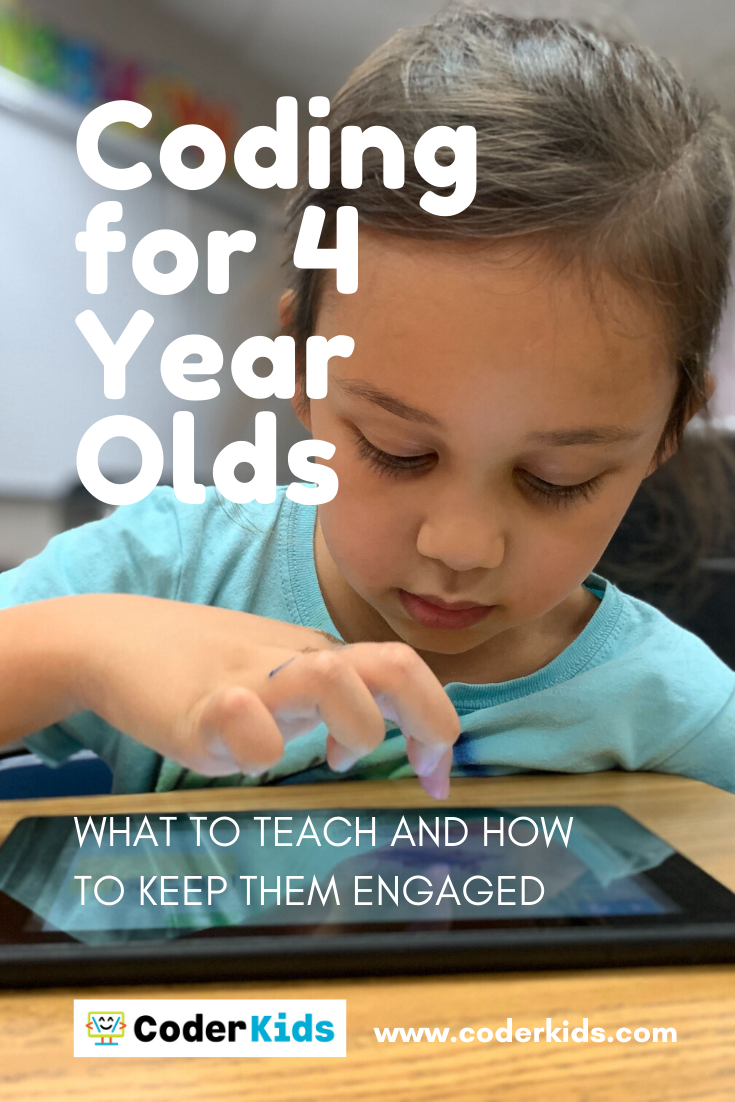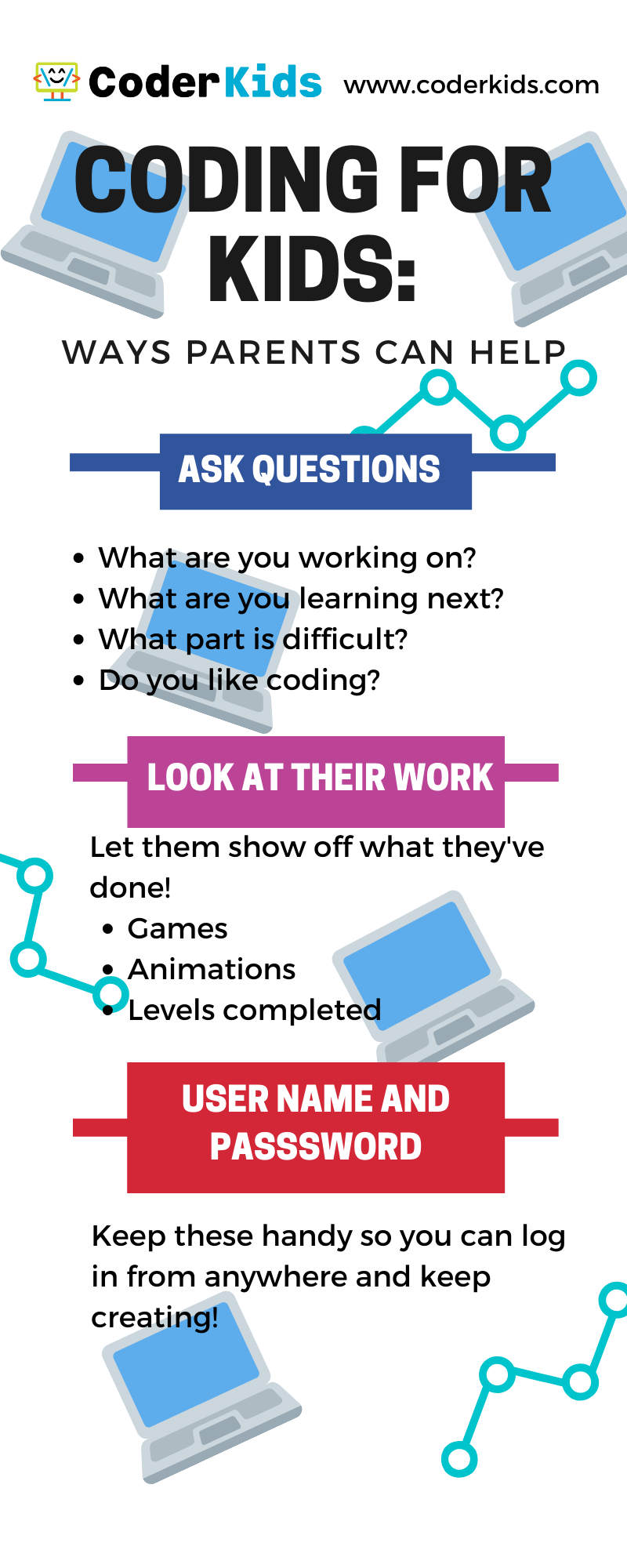Coding for 4 Year Olds
For information about Coder Kids classes and camps, including online ScratchJr classes, visit register.coderkids.com/onlineclasses.
Can 4 year olds learn to code?
Should they?
Here at Coder Kids, we say YES! to both of those questions! (if you’d like more info on why young children should code, check out this blog post )
When teaching 4 year olds to code, we aren’t focused on getting them to design the next great video game- that is not the level they are at in their coding journey. What we are focused on is teaching them basic coding concepts that are crucial to understand and master in order to progress and advance coding abilities.
4 Coding Concepts for 4 Year Olds
There are 4 basic coding concepts 4 year olds can and should learn. They are:
Logic
Decomposition
Sequencing
Patience
Let’s take a look at these 4 concepts, what they are and why they are important. Then we’ll discuss ways to help 4 year olds understand them.
Logic
In coding, logic refers to the structure and arrangement of a task. If your task is to code a robot to cross the room to point A, you could technically have him spin around in circles, go into another room first, and then go to point A. But the most logical (most efficient structure and arrangement), is to simply code him to go in a straight line to point A.
Decomposition
Decomposition is breaking a larger task down into smaller, logical steps. It is imperative for coders to understand that they must tell the computer (or whatever they are coding) EVERY SINGLE THING it needs to do. Even if something seems obvious to us, it’s not to a computer. A computer can only do what we code it to do. So if we want to get the robot to point A across the room, we would need to break it down into smaller steps: turn to the left, take 4 steps forward, quarter turn to the left, 10 steps forward, stop (at point A).
Sequencing
Sequencing means the order in which directions are given. Even if you have broken your task down into small, simple steps, if they are coded in the wrong order, it won’t work. Because the computer can only do what we tell it to do in the order we tell it to do it.
Patience
Patience in coding is the same as patience in any facet of life: the ability to tolerate trouble or difficulty without getting upset or angry. Because learning to code involves a lot of trail and error, it can be frustrating at times. When kids learn early on that this is normal and to slow their thinking down and look for solutions, they will be ahead of most when in their coding journey.
Teaching the 4 Coding Concepts
Now that we know what the best concepts to teach 4 year olds are, how do we do it?
While there are infinite possibilities of how to teach theses concepts, here are 4 ways that we have found best engage this age group.
Variety
Variety is key with younger children learning to code. Their ability to focus and attention spans are simply not as developed as children who are older. We use a variety of activities with this age group to keep them excited and engaged. Typically, we recommend doing each activity for 15-20 minutes at a time. Besides a time limit, there are tons of great games, apps and websites that can be utilized as a way to add variety to learning to code. For instance, you could use the Lightbot app for 15-20 minutes (which focuses on decomposition and sequencing). Then the next time use Osmo (which uses tactile coding blocks), and after that, ScratchJr (which allows for more creativity in the coding projects). By using different methods of teaching coding concepts, young learners will remain engaged
Offline Activities
It is also important to show kids that they can learn about coding offline as well. There are tons of offline activities that reiterate the concepts of logic, decomposition, sequencing and patience. Check out this blog post for 3 great offline coding ideas! You can also implement concepts of coding into everyday activities. Having the kids make a list of instructions (sequencing) for a daily task (like brushing their teeth), and breaking it down in to small steps (decomposition) is an easy way to include coding in even more mundane tasks. There are also a wide range of books and board games that focus on teaching coding concepts offline. Offline activities are another great way to add variety to learning to code activities.
Creativity and Letting Them Make Mistakes
Be sure to allow for kids to be creative and to make mistakes! Sometimes it’s hard to let them fail when we can see (using logic) that their code is not going to work. This is an important experience for them to have! If we don’t let them, they won’t learn the basic concepts and they will not be developing patience or resilience either! We have found that allowing students autonomy in their learning (giving them opportunities to be creative in their projects, deciding on the sequencing themselves), keeps them engaged and yearning to learn more so they can fix their mistakes and bring their ideas to life.
Fun
Coding has to be fun for 4 year olds to want to do it. They will not be motivated to learn if if feels like work or a punishment. Be sure to include breaks during their learning. This helps them refocus and get some energy out. Positive attitudes about coding and making mistakes go a long way in nurturing a fun and captivating learning environment.
What ideas have you tried for teaching 4 year olds to code? Let us know what has worked best for you!
As an Amazon Associate, Coder Kids earns from qualifying purchases.







